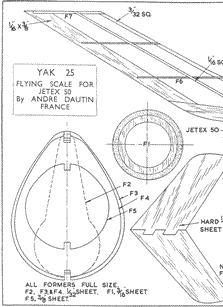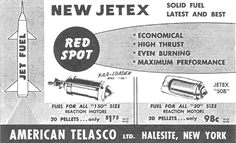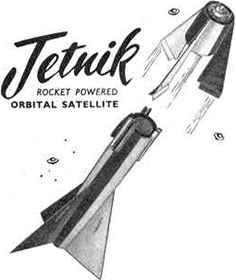|
|
|
|||
|
|
||||
|
|
||||
| The (Jet)X Files | ||||
|
|
HOME | SITE MAP | FORUM | CONTACT |
|
||
|
ABOUT | MOTORS | MODELS | ARCHIVE | HISTORY | STORE | FAQ | LINKS
|
|
|
|
|
|
||||||||||||||||||||||||||||||||||||||||||||
|
The (Jet)X Files 16
for April 2004
by Roger Simmonds Reprinted from SAM 35 Speaks, April 2004 Afterburning I was very pleased to receive two requests for plans of Sigurd Isacson’s Jetex 50 powered J-35 Draken following the (all too brief) review of Scandinavian Jetex designs in January’s column. Isacson also produced a kit for the little J-210 ‘proof of concept’ Draken, which flew in 1951, but I have no plans for this one. Interestingly, before this Saab, had also made a 1/7 J-210 for tethered flight. This ‘C/L’ model was powered by a 51/2 lb. thrust pulse-jet (see Model Aircraft, Jan. 1955). |
|
||||||||||||||||||||||||||||||||||||||||||||

|
|
 
- Photos by Chris Strachan
|
|||||||||||||||||||||||||||||||||||||||||||
|
Graham Potter has sent me a photo [right] and details of his latest ‘take’ on the F-117. His first version was quite large; I don’t know if Graham ever tried it with an L4, but it certainly needed at least a ‘high power’ (‘250mN’) L2 HP. His new model is smaller, and he hopes it will be suitable for a standard (110-140 mN) L2. Graham writes; "It was finished some time ago . . . it weighs 32gms (half the first one) and the span is about 12 5/8". I have done some gliding with it and it looks rock steady, but powered flights will be at Old Warden this year". I can’t resist juxtaposing Graham’s F-117 with Benson-Ball’s XD-20. I don’t think I was exaggerating in last month’s column when I said that BB’s designs were both ‘vintage’ and ‘futuristic’, and the two models, though they are fifty years apart, could be contemporaries. |

- Photo by Graham Potter
|
||||||||||||||||||||||||||||||||||||||||||||
|
Ron Marking, who works for
West Wings, had also been thinking of a Rapier conversion of the
rubber powered F-117. He wrote to me; "I was very interested in your reference to the F-117 Stealth in November’s column and I showed it to Peter Shepherd, the designer. He was very impressed [I think with Graham’s model, not my verbiage]. I asked Ron whether the Rapier option could be shown on the plan, and if Mr Shepherd had thought of designing some models for these motors". Ron replied: "With regard to the Stealth, unfortunately we get plans printed by the thousand and have many in stock. Any change would incur another ‘set-up’ charge, so there are no thoughts regarding such a modification. With regard to future models, again no luck! Rapiers are only available from specialist dealers, not from your average toyshop, so sales of kits of models designed for these units are relatively low. When you consider the cost of plan production, label printing etc, any kit of a small and low cost model needs to sell a few hundred a year for several years before it becomes a worthwhile proposition, especially as we sell through wholesalers and not direct". This is understandable, if rather a pity. Fortunately, Aerographics produce modern kits for Rapier power, and Tony Betts of |
|||||||||||||||||||||||||||||||||||||||||||||

As we have seen from some previous (Jet)X Files, reaction motoring was popular in France. Jetex, though British, was quickly taken up in that country, and there are some very nice French designs on the Jetex.org website. One of André Dautin’s first designs, the ‘Yak 25’ appeared in the 1953 Aeromodeller Annual [right] (see also SAM 35 Speaks (March 1991). This design was notable for the ‘0°’ dihedral of its swept wing and a Jetex 50 conveniently mounted in the rear of its fully sheeted fuselage (a position very suitable for a lighter Rapier). The source of this elegant free flight ‘scale’ design is something of a puzzle, as it bears more of a resemblance to certain German experimental designs (for example the Focke Wulf Ta 183) than to any extant Russian prototype. Despite its dubious provenance, it is most attractive and well worth resurrecting. Dautin’s article ‘Le vol circulaire avec Jetex’ (Modèle Réduit d’Avion, May 1953) reported that he and his friend André Vacroux, (famed for his Jetex Helicopters) achieved "results in general agreement with those of the British modellers". He continues: "take a look at the model [right] – it’s quite small and doesn’t demand much building experience or expenditure. Ten francs for the material, a quarter of an hour’s work, ten centimetres wingspan — this is truly reaction-powered flight that within everyone’s reach." The construction was conventional and very similar to Tinker’s techniques. Dautin recommended, (and I had forgotten we did this), "testing should first be carried out using whip power, but with the Jetex motor in place". He continues: "a smooth level flight should be the aim. If it flutters, modify the CG by adjusting the longitudinal position of the motor. The underside of the craft should be polished smooth and the take-off strip should also be as smooth as possible to facilitate taking off. A clockwise direction of flight will prove most convenient, allowing you to withdraw the fuse and move out the circle in timely fashion. For take off, point the nose slightly towards the outside of the circle". I think we British flew anti clockwise, as trimming with whip power then felt more natural to us control-liners. I must thank John Miller Crawford for both the plan and the translation. Dautin’s other contributions to the Jetex genre included one of the first independent designs for Jetmaster and augmenter tube: a Convair |
|

- Aeromodeller Annual, 1953 (p.46)

- Modèle Réduit d’Avion, May 1953
|
|||||||||||||||||||||||||||||||||||||||||||
|
|

- Modèle Réduit d’Avion, Aug. 1954
|
|||||||||||||||||||||||||||||||||||||||||||
I was looking through an old Aeromodeller Annual the other day, (as one does), and I came across an article on model rocketry, written, I think, using material collated from Estes advertising copy. All good stirring stuff, but there was a surprising lack of any reference to past endeavours in the model rocketry field. This, whilst understandable in an advert, is inexcusable in a proper article. Model rocketry has a venerable history going back at least to Herman Oberth, and sophisticated and well-engineered rockets were popular in the US even before Sputnik (see Aeromodeller, Dec. 1952). Such activities were of course, illegal in the UK. Joe Estes marketed a variety of small models powered by his own black powder motors in the US in the mid sixties, but these were aimed at the hobbyist; a market niche Jetex had previously explored, albeit in a small way, more than a decade before. The 1951 ‘Zyra Spaceship’ [above], being powered by a standard Jetex 50, was not able to fly in a ballistic fashion, except, perhaps, as a result of a good (and possibly frustrated) chuck. The 50 could, however, propel small and light ‘canard type’ missiles quite spectacularly, and Peter Cock had great fun with these sorts of ad hoc models (see photo [right]). These may have been the progenitor of the later (Sebel) ‘Viper’ silhouette missile. The Viper’s flight pattern was described in the instructions thus: "the model should climb at a shallow angle until full thrust is obtained, when it will climb nearly vertically to a height of 200 ft". |

- Peter Cock
|
||||||||||||||||||||||||||||||||||||||||||||
|

- American Modeler, March 1963

- American Modeler, June 1959 (p. 54)
|
||||||||||||||||||||||||||||||||||||||||||||
|
Peter Cock designed the shapely ‘Dan Dare Spaceship’
around the 50R. Despite adverts claiming a "close association with the authors
and publishers of the Eagle", in truth it had little to do with Dan Dare,
Rigby, (or even Professor Peabody of fond memory). It was reviewed in ‘Trade
Notes’, Aeromodeller, March 1955. Peter’s other model for the 50R,
the ‘Jetnik,’ was, as the name implies,
post-Sputnik and appeared in 1958. I have been unable to find any reviews
of this Sebel product. Can any reader help? The Dan Dare Space ship was most ingenious. The motor pressed on a spring-loaded catch; when the fuel was exhausted the catch released and the parachute deployed (see photos). One problem with the comparatively low power-to-weight ratio was marginal stability at lift-off; Peter overcame this with a substantial spring-loaded launch pad to give a high initial acceleration. The beautifully presented kit this was most attractive to ‘Space-minded’ and Eagle-reading juveniles. Aeromodeller called it a ‘proverbial Pandora’s box’ and praised the extensive prefabrication of both the launch pad and the rocket, which was well up to 'tailored' standards. It was, though, understandably but unfortunately, quite expensive at 47/6d. The launch pad, which had a sturdy plywood framework and could propel the model to 15 feet without the motor, was, so the advert claimed, "for use not only with the Spaceship, but is designed for launching high-speed flying aircraft and miniature guided missiles". It needed careful assembly and was most emphatically not for the careless or inattentive: Aeromodeller commented that it had "a formidable battery of coil springs and triggers […] operation of the mechanism strikes one rather forcibly [oh dear!] as the recoil is akin to a powerful air rifle". The preparation of motor and propellant also required care and a modeller expert in the ways of Jetex; and even with twelve inches of wick miss-fires could occur, or at least be suspected. Peter tells the story of one such occasion at a demonstration of the rocket; "I picked up the model to check […] whilst I was holding it the motor came to life […] the rocket shot past Mrs Mansour's shoulder!" Her reaction, if any, is not recorded. Perhaps it was the sort of thing she was used to. |

- Roger Simmonds
 |
||||||||||||||||||||||||||||||||||||||||||||
|
Though it retained the ‘tailored’ balsa shell construction, the Jetnik [right] was a much less sophisticated product, and required a large elastic catapult for launch. As has been amusingly told by John Emmet in SAM 35 Speaks (Oct. 1988), this needed to be released at exactly the right moment after lighting the fuse so that the 50R powered ‘satellite nose section’ was in the correct orientation (pointing upwards) at separation. This could ascend to 300 feet, twice the height claimed for the Dan Dare Spaceship, but there was no parachute, and ‘post-flight’ location of this tiny second stage with its precious motor was, and here I speak from experience, a somewhat desultory experience. Whether these Jetex rockets can be resurrected is an open question. Kits do turn up (though at a price), but apart from using an antique 50R motor and old fuel, I do not know what could be used to power them. Perhaps a knowledgeable reader could suggest an Estes motor equivalent to the Jetex 50R/HT suitable for these, and other, models, (for example Ian Geddes’ unique ‘Coccinellida’ 1956 VTO coleopter). Is there a 'Vintage Rocket Society' analogous to SAM, and, if so, what do they fly? |

- Royal Air Force Flying Review Oct. 1958
|
||||||||||||||||||||||||||||||||||||||||||||
|
|
|||||||||||||||||||||||||||||||||||||||||||||
|
|
|
||||||||||||||||||||||||||||||||||||||||||||
|
|
|
|
|
|
|
|
Acknowledgements - Article: Roger Simmonds - Illustrations: Roger Simmonds, Graham Potter, Chris Strachan, MAAC archives via Bill Henderson, Peter Cock via Roger Simmonds |
|
|
|
|
ABOUT | MOTORS | MODELS | ARCHIVE | HISTORY | STORE | FAQ | LINKS |
|
|
Terms of Use
|
Queries? Corrections? Additions?
Please
contact us.
|
|